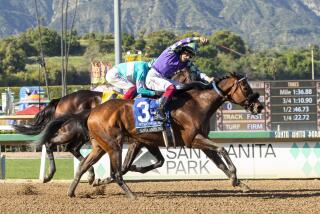Yearling Price Decline May Lead to Changes in Racing
- Share via
WASHINGTON — The marathon fall thoroughbred yearling sales have ended, and the results were as bad as the pessimists in the breeding industry had feared. The plunge of prices in Kentucky makes the recent decline on Wall Street look like a tea party by comparison.
When prices dropped at the prestigious Keeneland Yearling Sales in July, some analysts thought that only the blue-chip sector of the market was collapsing. The averages had indeed been greatly affected by the unwillingness of the top two or three buyers to pay astronomical prices for individual yearlings (like the $13.1 million record set in 1985).
But the decline in prices at the Keeneland and Fasig-Tipton fall sales, which typically sell horses in the $20,000 to $100,000 range, verified that the collapse has cut across the whole industry, and that major changes are imminent in the breeding and racing business. For sharp horsemen, the opportunities for profit are enormous.
The average price of a fall sales yearling dropped 13% from the 1985 level, but that figure does not begin to suggest how drastically the market has been shaken. Consider the case of the stallion Assert.
The well-bred colt won the French and Irish derbies, and went to stud in 1983 with all the necessary credentials for success. Breeders paid anywhere from $100,000 to $125,000 to send a mare to Assert. Last year, his yearlings brought an average price of $249,000. This year, Assert still looms as a successful stallion, but his yearlings averaged $45,000. The people who paid those $100,000 stud fees in 1984 to get their 1986 yearlings took a beating.
Overall, the 2,377 yearlings sold in Kentucky this fall brought a total of $64 million. The stud fees for those horses cost $58 million; raising them cost approximately $28 million; the dams of the yearlings costs tens of millions more. So just about everybody got clobbered.
This does not mean, however, that it was easy and cheap to buy a good yearling. Many buyers said that there was intense competition for horses in the $50,000 range. The problem for the sellers was simply that they had paid too much for stud fees when they bred those horses in 1984. The market was booming then, and breeders who had sold yearlings for big money had plenty of cash to pay those fees.
The opposite conditions prevail now. “The breeders who sold horses this summer and fall have got to take their 1986 revenues and pay stud fees next year,” said Bill Oppenheim, editor of the industry newsletter Racing Update. “And they are not going to pay ridiculous prices. In fact, there are a lot of cases where people should be paid for breeding to certain stallions. Stud fees are going to crash.”
Just a few years ago, investors stampeded into the breeding market. People with no interest in the sport were buying mares and stallion shares because their accountants and stockbrokers told them it was the thing to do. Now that they have been burned badly, these same investors are going to be bailing out of the horse business.
“The people who got in when the market was at its highest are going to turn around and get rid of their mares at the November sales,” Oppenheim theorized. “The cagey breeders who are in the business for the long term are going to come in to buy.”
With the prices for breeding stock and yearlings plunging, and with the purses for top-class races at an all-time high, there has probably never been a better time to buy horses. Unfortunately, many breeders who have been selling horses in 1986 don’t have much money left to take advantage of the opportunities.
More to Read
Go beyond the scoreboard
Get the latest on L.A.'s teams in the daily Sports Report newsletter.
You may occasionally receive promotional content from the Los Angeles Times.










